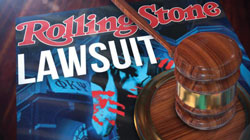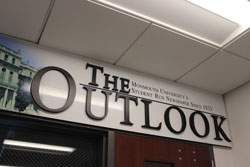A ten-person jury found Rolling Stone writer Sabrina Rubun Erdely, the magazine itself, and publisher Wenner Media guilty of defaming Nicole Eramo, an administrator at University of Virginia, with malice, in their publication of their sensationalistic 2014 article “A Rape on Campus.”
The story, while now discredited, claimed that the school botched the handling of an alleged fraternity-house gang rape. “Jackie”, the pseudonym of the student who was allegedly attacked, claimed to have been counseled by Eramo; in her testimony on Oct. 31, 2016, Eramo claimed that Erdely portrayed her as ‘the chief villain’, and as someone who discouraged victims from reporting assaults to the police. Eramo, the associate dean of students, had been in charge of the university’s sexual assault program.
The fraternity named, Phi Kappi Psi, also immediately challenged the article after it was published. They are also suing Rolling Stone for 25 million dollars; their trial is scheduled to begin next year, according to CNN.
According to USA Today, Erdeley e-mailed her editors within days of publication, saying that the magazine needed to run a retraction of the story. An editor’s note was added more than two weeks after publication, but the story was not removed from the online website until April 2015.
“When I first read it, I found it sensationalistic and inadequately sourced,” said communication professor Eleanor Novek, who is also a researcher in the field of social justice journalism. “It seemed that Rolling Stone was using this young woman’s story to generate voyeuristic publicity, not to help inform people about the widespread problem of campus sexual assault.”
A police investigation found no evidence to back up Jackie’s claims. According to a commissioned report by the Columbia University Graduate School of Journalism, the magazine “made a series of journalistic errors”, such as relying too heavily on ‘Jackie’s’ uncorroborated story; the report also blamed the magazine, not Jackie, for the botched piece.
“General journalistic practice calls for multiple sources on any issue and on any story,” said Novek. “Particularly, when accusations are being made, it is imperative that journalists confirm accounts, verify information with multiple sources, and allow people to respond to allegations. If the magazine had done this, Rolling Stone would have wound up with a story that was not as explosive, but more accurate.”
Attorneys for Rolling Stone said there was no evidence that Erdely knew that what she wrote about Eramo was false; lawyer Scott Sexton also noted that Eramo had believed ‘Jackie’s’ rape story.
“This young woman was very good at telling a story,” said Sexton during the court case. “We are the ones being tried, in a sense, for having believed her.”
Novek also said that the magazine should have worked harder to either corroborate or debunk the information, and said that if the account could not be confirmed, it should have not been the centerpiece of the article, but rather “a broader, less sensational exploration of sexual assault on college campuses” and more accurately described the account as “the unconfirmed self-report of an anonymous victim”.
“An aim of ethics in journalism is to ensure we get as close to the truth about people, places, and events as we can,” explained Claude Taylor, a communication ethics professor and the University’s athletics professor in residence. “Press ethics are built upon objectivity and impartiality in the practice of collecting and reporting the news. There is a critical lack of trust in the media and if they are to fulfill their traditional role to inform citizens and contribute to an effective democracy, there needs to be a strong return to ethical principles.”
He explained two forms of ethical approaches that could have been used to prevent the controversy. The first, virtue ethics, would have called for taking the time to verify sources, and would have afforded impartiality. Rules-based ethics would have been used to apply a set of journalistic ‘checks and balances’ to the magazine.
In my opinion, yes,” said Taylor, when asked if he thought proper journalistic ethics could have prevented the controversy from happening. “Limits on certainty would have helped keep the story from getting away from everyone. Plus, following traditional press ethics could have tempered the ‘hype’ around landing the scoop.”
After the Nov. 4 verdict, the magazine released a statement admitting to journalistic “missteps” and apologizing to “anyone hurt by them, including Ms. Eramo”. The magazine also said that “it is our deep hope that our failings do not deflect from the pervasive issues discussed in the piece, and that reporting on sexual assault cases ultimately results in campus policies that better protect our students”.
It is a terrible setback for the reporting and investigation of sexual assault and acquaintance rape,” said Taylor. “I worry that many victims’ stories will fade back into the shadows at a time when we have begun to make progress to make colleges and universities safe for everyone in the community.”
Sexual assault is a very real problem on college campuses,” said Novek. “One case of sloppy journalism should not serve as a distraction from the efforts necessary to stop sexual assault.”
Monmouth University itself has taken several steps and instituted programs to attempt to reduce sexual assault on campus, according to Mary Anne Nagy, Vice President for Student Life and Leadership Engagement. A recent poster campaign, titled “It Happens”, has posters showing how sexual assault can happen to anyone, anywhere, in a series of chilling photos. The University Code of Conduct has been updated, and Haven, an online prevention program, is now available to more students. The University has also made efforts to more effectively train the people who hear sexual misconduct cases.
The University also holds a ‘Sexual Assault Awareness Week’, meant to educate and raise awareness about campus sexual assault through a variety of programming such as panels, discussions, and presentations.
PHOTO TAKEN from wdbj7.com



